Part 2: Grasping the Very Basics: The First Turn
Grasping the Very Basics: The First Turn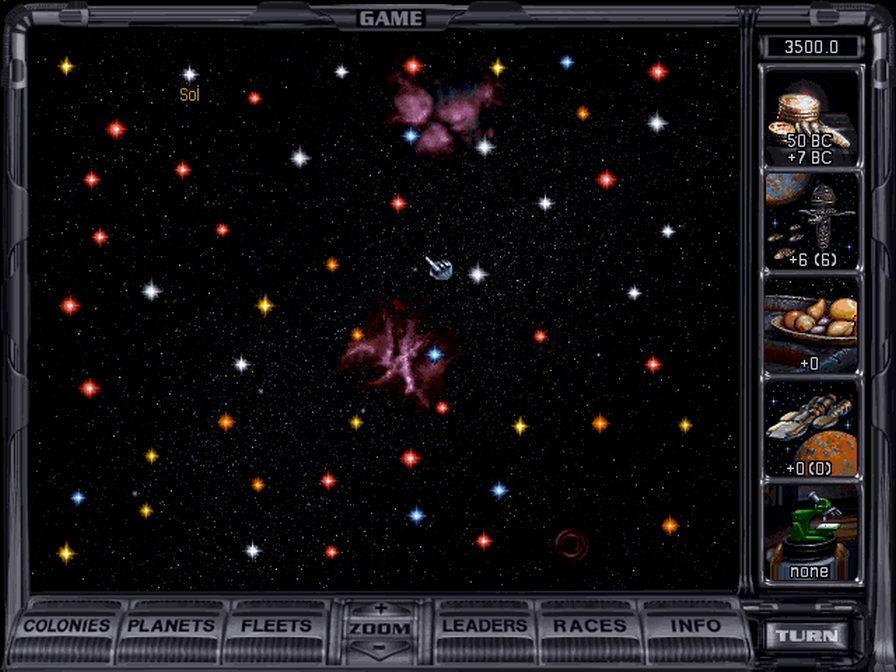
Huddled in the Situation Room, this is the display on the main wall screen as generals, admirals, high-ranking politicians, and other manner of dignitaries are busy at various tasks and/or doing their best to look it. As Immortal - or at least nearly so - Emperor of your people, this is the nerve center of your galactic empire. That's a shockingly pretentious title for where we actually are to start off pre-warp, but we'll get there, at least for a time.
Officially, this is the Galactic Command Interface. Not the most inspiring name, but it's functional. Let's go with GCI for short. Much is familiar, but there is definitely some that is new. For our immediate purposes, we'll just note a couple things.
** The GAME button in the upper-middle escaped my notice for quite a while when I first played. I had no idea how to save/load etc. and there are settings under there that we'll leave at default for now and get to later. It's just kind of strange to me that it blends in as much as it does and is sort of an afterthought.
** In the upper-right, the STAR DATE. That's literally what the game calls it. Small clap for being able to know the current turn from the main screen at all times. But with that we must scratch our head. MOO2 definitely doesn't have a consistent relationship with it's own timescale or storyline. Last time out we began in 2300. Here we are 1200 years into the future. That's not a small jump, and it's the same year regardless of what your starting tech level is. Over a millenium in the future, same races starting out in the galaxy at the same general capabilities beginning from their respective homeworlds? This is not a big deal from a gameplay perspective of course - the current stardate matters only in relative terms. It's just that it is sort of pointless and has no even attempted justification that I'm aware of ... so just why?
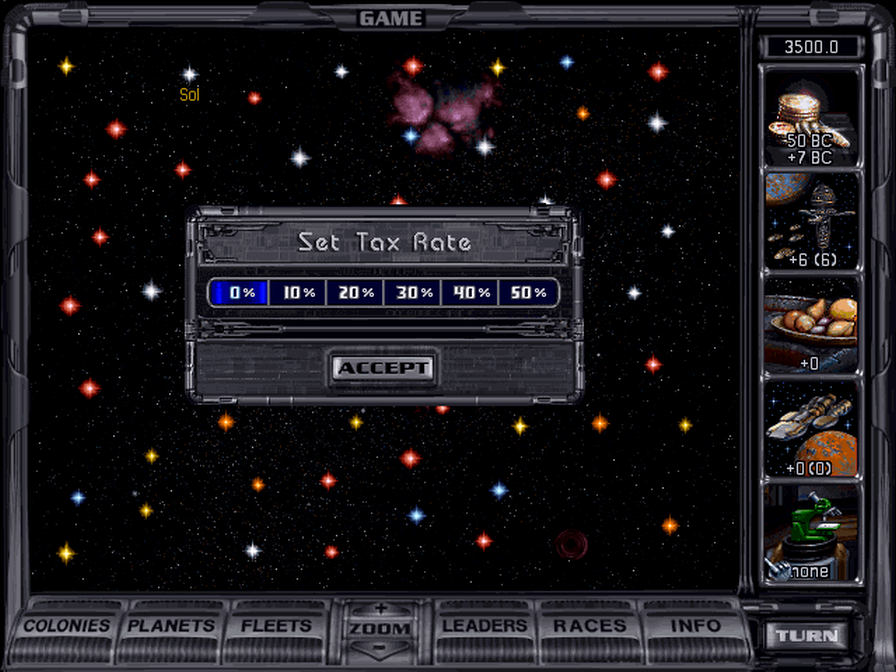
Just below the stardate is the Reserve display - the coin picture. We start with 50 BC and a healthy positive balance. Click on that panel, and you get this tax pop-up. It really confused me for a while that you have positive income with no taxes. Like many things, the reserve works differently in this game. It's enough for our purposes to note taxes are currently at 0% and we can increase them if we need more cashola.
Other imperial stuff can wait - let's take a look at our homeworld. Unlike MOO1, we can't do that from this screen.
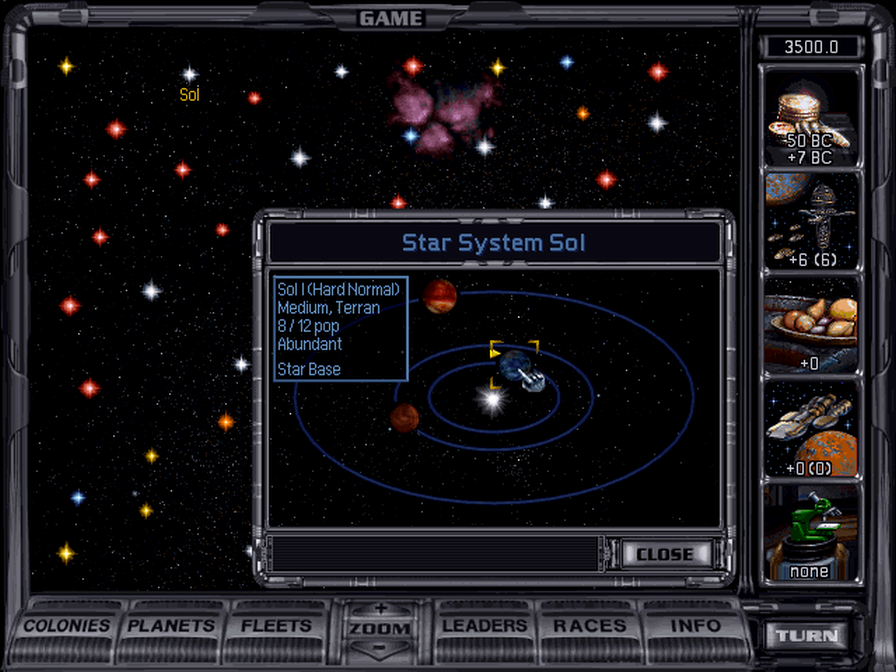
Click on our system, the only one we've explored, and we get this. We have multi-planet systems now! Generally you have another crap planet or two around your own star. We have a Gas Giant, which are all uninhabitable, and ...
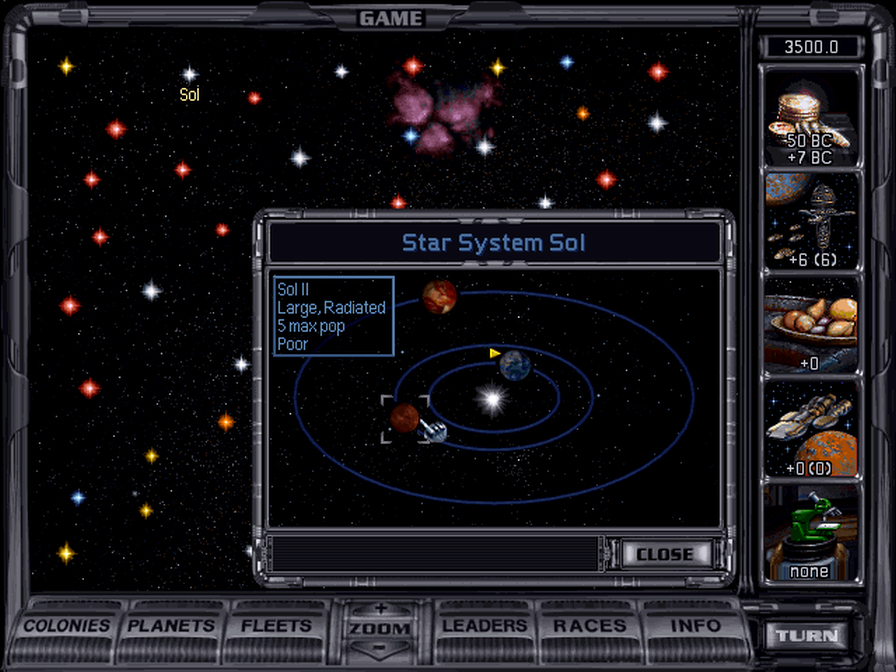
Yep, it's crap. Researching hostile landing tech is not a thing. We can land anywhere - the question is whether it's worthwhile to do so. The 'grab everything in sight' protocol from our original MOO adventures is gone.
** Pro-Tip: When in doubt, right-click. This should be in neon capital letters about 500 pixels high in some unavoidable pop-up soon after you start up the game for the first time. Instead it is recommended as an aside deep in the in-game help somewhere. But while it's not obvious, one really really good design choice that was made on this game is that you can get more information about literally almost anything by right-clicking.
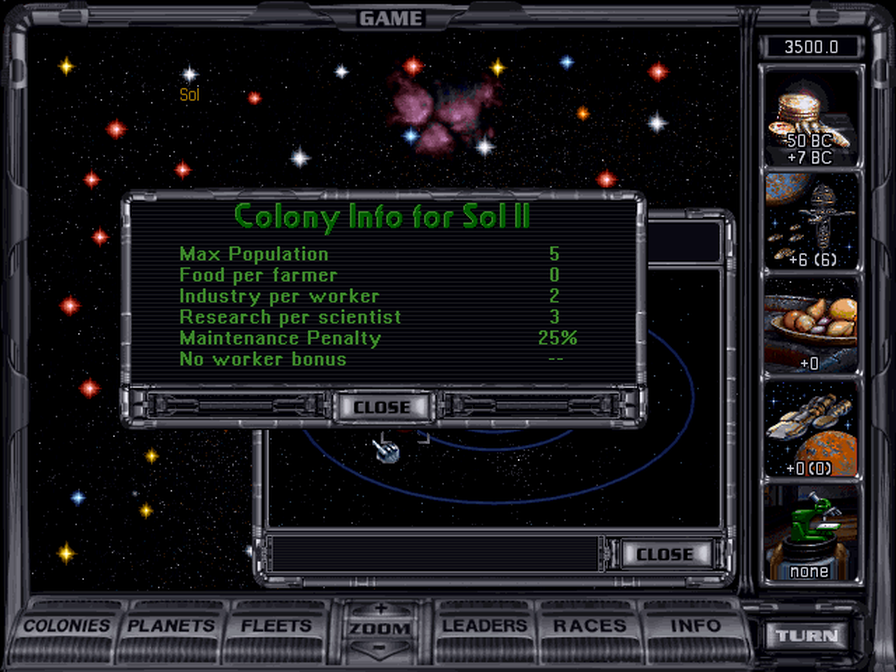
Obviously these are very small max populations - we'll get to that, but these are in millions and 10M was the lowest possible in the first game. Food and farming is a thing, we've got maintenance penalties and worker bonuses ... we're not in Kansas anymore. Let's dive into our homeworld finally to understand what some of this means.
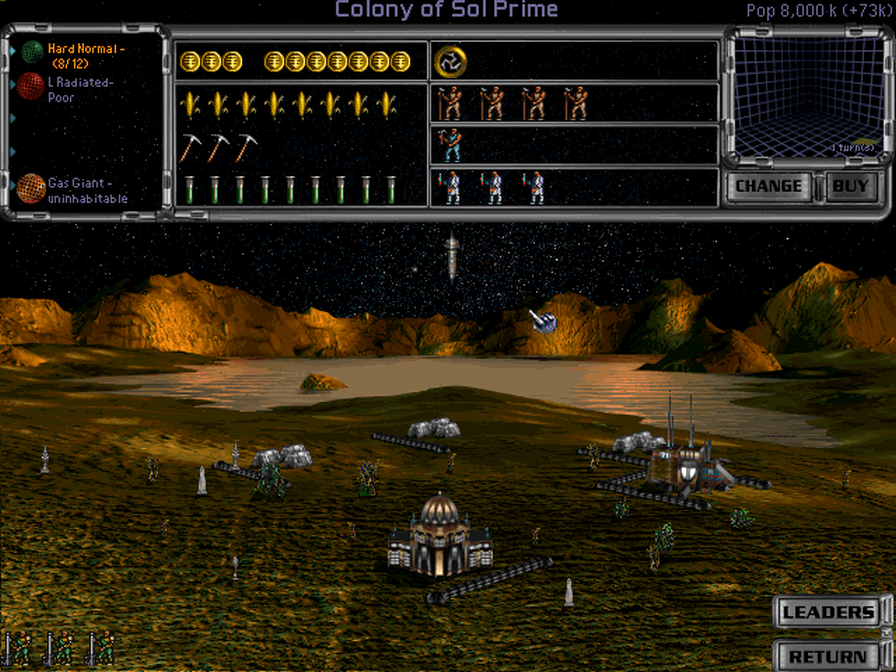
There is a slightly faster way to get to this screen, but clicking on the system then the specific planet is the most natural/intuitive way. At the upper-left we can see that every system has up to five potential orbits, and we can switch between/get more info on the local planets that way. So clicking through the system itself really isn't necessary or even useful when you get right down to it.
Planetary Resources
Right, let's get to know this place we're matriculating from. The label across the top is dynamic, which is a cool touch - it'll change to 'Industrial Colony' or 'Agricultural Colony' or 'Research Colony' if you focus a lot of labor in a specific area. Population in the upper right is given with precise growth that will occur at the current distribution of labor. We get a new 'citizen' for every 1M population. 8M pop gets you the same of everything as 8.999M does. So for the purpose of getting things done, all that matters is how many citizens you have on a planet.
** Money - 1 BC of reserve income is generated automatically by each citizen; unlike MOO1, production and money are entirely separate concepts. This is distinct from the taxes we discussed earlier - it just happens naturally. I imagine some sort of global sales tax or VAT is in place here, a tax on personal income/commerce or what-have-you. You might well wonder about the gap between the coins here:
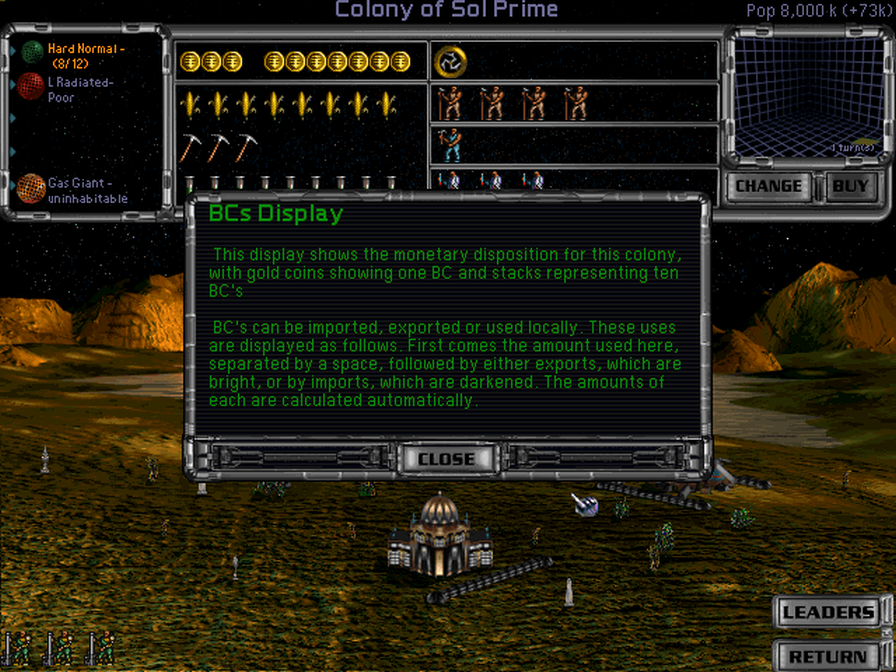
Main thing there is that we are actually spending the first 3 BCs on stuff, which is why they are separated. The rest is the profit.
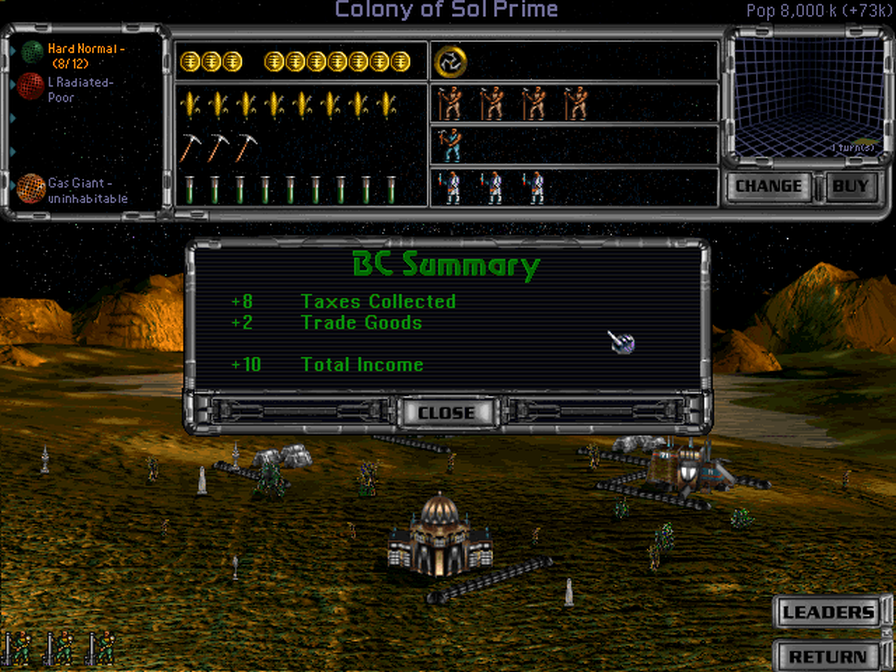
The previous desc. was the right-click option, this is left-click. That's how all these screens work - left-click is 'functional' and right-click is 'tutorial/exposition'. We'll get to what trade goods are but main thing here is to see what our financial income is on the planet.
The next section across displays the symbol for what type of government we have, and any morale effects. We have a neutral Morale right now, so all we get is the governmental symbol.
** Food - Four farmers doing their thing on the next line down. Each citizen needs one unit of food per turn. If they don't get it, population growth will slow down or even reverse. You can lose citizens this way, though I don't think you can have a colony starve out completely. It is also possible to export excess food eventually, though I can't do it yet here. Surplus is automatically sold off at a base price of 1/2 BC. The amount of food produced by each farmer is dependent on the environment. That's the single biggest problem with our sister planet Sol II - you can't farm on a Radiated world. So we'd have to import food there to make anything happen.
** Industry - As mentioned, production and finances are separate in this game. We have one worker producing three industry at the moment. Pollution is handled here as well - I'll get to that in a bit. Also, if we increase taxes to the Reserve, this is where they come from. Being schooled in Lords of the Realm and other titles, I expected a morale hit from taxes, but it directly takes away from industry. 10 Industry with a 20% tax rate means 2 more BCs in the reserve and only 8 effective Industry going to whatever.
The mineral resource level of a planet determines how much base Industry you get per worker. I keep using the term 'base' because all kinds of stuff will modify this later. Fundamentals first. We have 'Abundant', which means 3/worker ... and it's a bit deceptive because that's actually the standard mineral resource amount. In true MOO fashion, we can also have Very Poor (1), Poor (2), Rich(5), and Very Rich (8). So a worker here does 50% better industrial output than one on Sol II would. That's another strike against that planet.
** Research - 3 Scientists presently produce 9 Research, at 3 each. Both planets have a base of 3 - this depends neither on environmental or mineral resources and is more consistent from one planet to another. Therefore, again in classic MOO fashion, Sol II would be relatively better at that than farming or industry, since it sucks at the first two categories. Of course there are still specials that can change research output.
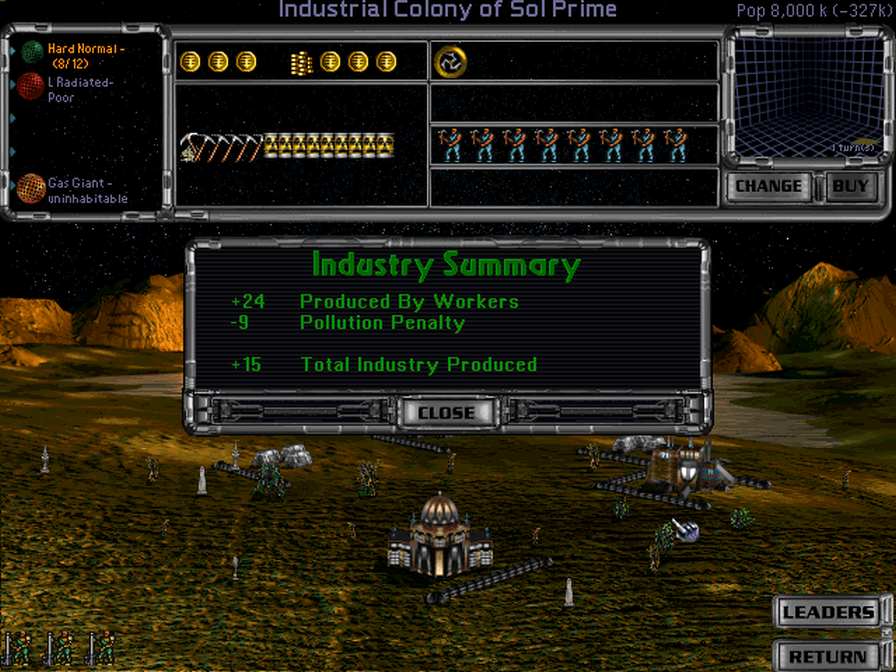
Let's say that, in a fit of stupidity, I decided everyone is needed in Industry. Well, you can see that I'm going to lose a whole lot of people to starvation. Aside from being a royal jackwagon of a despot, this is also going to make a lot of pollution, eating a sizable amount of the extra effort. The calculation for pollution is a bit complicated, but basically each planet has a certain amount of pollution-free Industry it can support. Above that point, some of your Industry will be lost as pollution, simulating the cleanup effort. There is no choice to simply not clean it up in MOO2, it simply gets subtracted from your production. At our starting level of things, once it kicks in we'll lose half of our 'extra' industry to pollution, and even worse the final resulting production is rounded down. So 2 workers are fine (6 Industry produced), but 3 workers will only produce 7 (9 - 1.5 pollution = 7.5, rounded down). 4 gives us 9 production (3 lost to pollution) and so on.
Planetary Economy Assessment
The citizen system is a definite, fundamental departure from MOO1, which worked on a five-category slider system. A couple of advantages of this change might be considered to be simplicity and limiting micromanagement. If you've played much MOO2 though, you know that neither one of those actually pan out once you get further into the game, and that it's actually harder to keep the 'spending ratios' you want in place long-term without making constant tweaks. Both systems require require regular adjustments for optimal play, while the original sliders give you more fine control over what investment to make where, and also provides a more natural, organic increase over time compared to the plateaus in the worker approach. This is one area where the original game is best.
On the other hand, I do really like the idea of exporting food to supply colonies that can't make their own, and the general concept of how the different planetary environments work. There's a lot more variety out there now. The idea of being able to land anywhere, but not necessarily profitably, is one that is attractive to me. Choosing where to colonize is made more important, so MOO2 gets the seal of approval in these aspects.
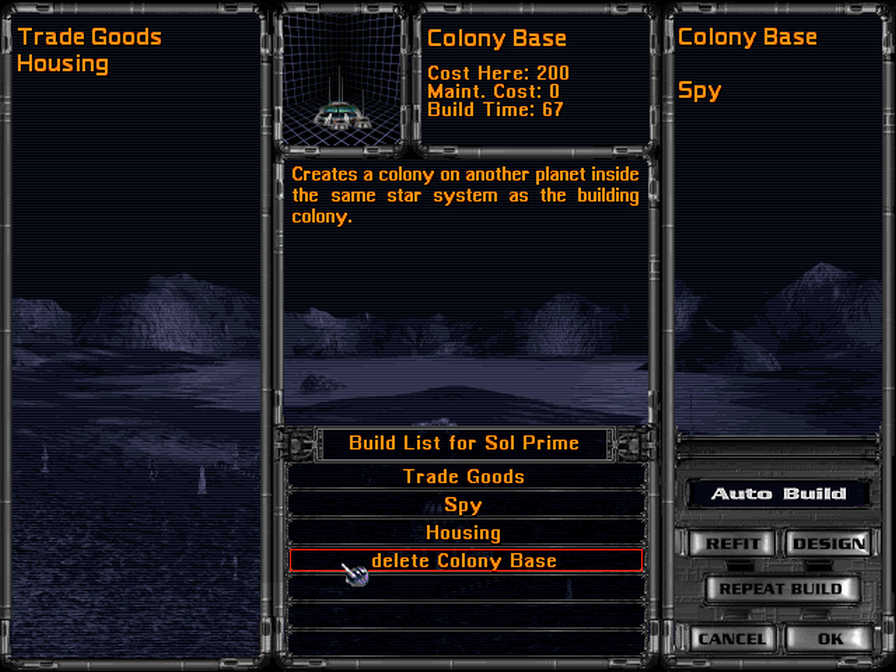
In MOO1, the only specific things you needed to select to build were ships. Here, the CHANGE button on the right of the previous screen brings up this. Which is mostly empty now, but it won't stay that way. Here is what all that Industry goes towards building.
The Colony Base shown can only be used in-system, which is a nice idea as a cheaper alternative to the Colony Ship we can't yet make. Spies are built planetside which is a major difference to get into later, designing/refitting/etc. is all for another time, but it's worth noting you can set things to be built repeatedly or turn this whole mess over to the AI with Auto Build. The two things on the left are 'settings', not actual tangible structures. That is, Trade Goods will produce more income from their sale - that's where that extra 2 BC we noticed earlier was coming from. Housing boosts population growth - switching to that would increase our gain from 73k to 83k per year. These allow a planet to use its industrial output in these areas if we don't need a ship or structure built at the moment. And there will be more. There will be so much more.
Looking at the Build List in the bottom middle, the game will warn you if Trade Goods/Housing are above other stuff because they will never 'complete'. They also don't use production overflow - i.e., if you've 'stored' industry by investing in a big project, switching to something else will transfer the effort. Trade Goods/Housing though won't dip into that, but just use the current turn's production. Selecting an item like shown with the Colony Base, I can either click again to delete it or else move it up or down the queue. If I clicked on the 'Spy' line, the Colony Base would move up to second, and everything below it move down a line. Takes a while to get used to using this, but it works well for setting up build orders that you don't have to mess with for some time.
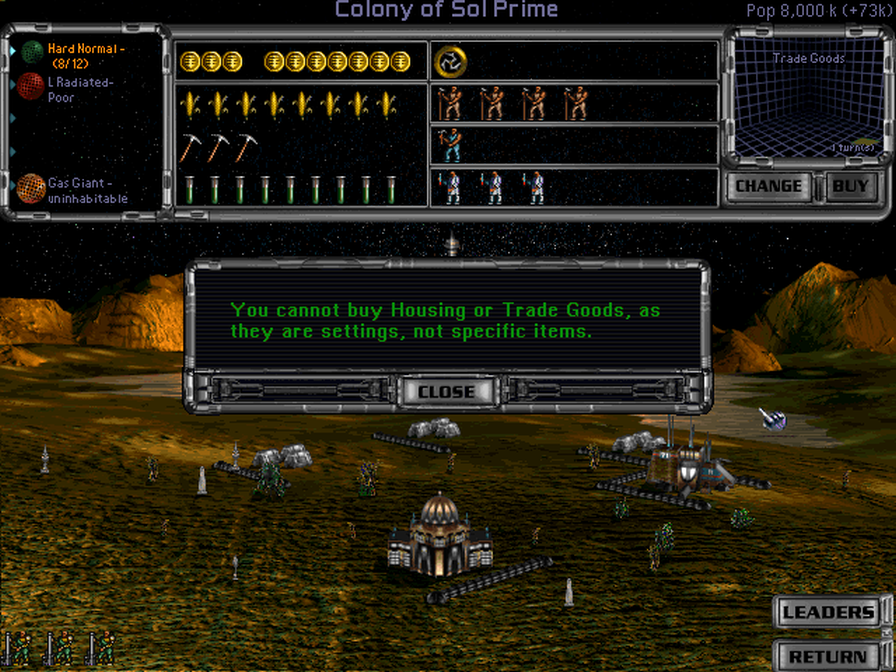
And then there's this. Planetary buildings, ships, spies, etc. can have 'rush jobs' done and just throw money at the problem. How much money depends on how much work has already been put in; it costs twice as much per Industry to rush something that hasn't been started as it has to finish one that's half-done. That part is a good idea, but I hate the idea in the first place of just being able to crack out that checkbook and say 'name your price' absent any semblance of the proper infrastrucure. You wouldn't want to, but you can go to a fresh new colony and demand immediate construction of the latest and greatest, top-of-the-line massive starship and get it done if you have the funds.
MOO1 got this part right by limiting it to doubling the current productive capacity of a planet no matter how much you have in the Imperial Reserve. This is a wheel that didn't need to be reinvented and made into a trapezoid.
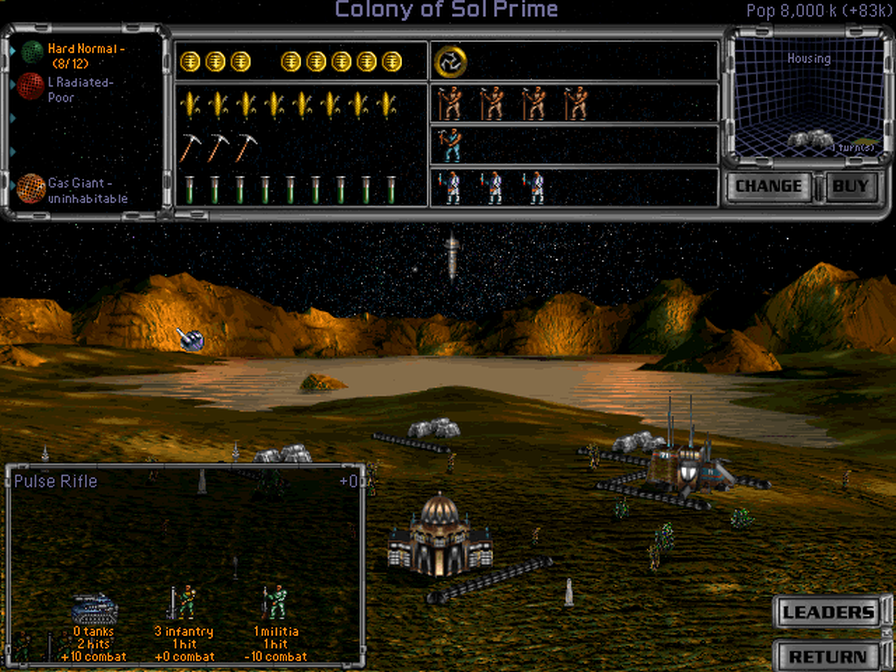
The soldiers in the lower-left of our main colony screen give us access to this pop-up. MOO2, you see, has this crazy insane idea that assimilation ought to be a thing. That is, that conquering a planet needn't involve murdering EVERY.SINGLE.PERSON on it - though that's still an option if you want to choose it. I'm a fan of this for sure in theory. In practice ... well, we'll get to that.
So our guys are armed with Pulse Rifles, which are baseline +0 and merit no bonus whatsoever. Naturally. We haven't invented Armour/Tanks yet, which as you can see can take twice the damage and are also just better at fighting. Those three guys in the middle are considered Marines, and then we also have a Militia. These troops are added to each planet that has a barracks on a gradual basis, one every few turns. That's supposed to continue until you reach the planet's maximum population, but I think it's actually less than that. Anyway, main point being there's a limit, and to invade a planet you need to bring enough to defeat these military defenders.
Both Barracks give a +20% morale boost, which we need as we'd have -20% without it. Morale is just a flat penalty on what every worker produces, and once again the remaining production rounds down so it's really important to not have a negative there. The barracks is the building on the right of our planet view. The big one in the middle is the imperial Capitol. You only get one of those and Bad Things(tm) happen if you lose it. The small whitish buildings are Housing, added automatically based on current population. And then in the top middle is a grey needle in space or whatever. That's the Star Base, which allows us to build larger-sized ships, provides extended scanning range, and has defensive weapons. It also serves a to-be-discussed-later administrative function. I think the Star Base is a bit of an anachronism in a Pre-Warp start, but it's there regardless. And we can scrap any of these buildings for a price if we want. The Star Base requires 2 BC maintenance, 1 BC for the Barracks. Building more of any of them has a long-term cost associated with it.
Ignore the LEADERS button for now, that's for another time.
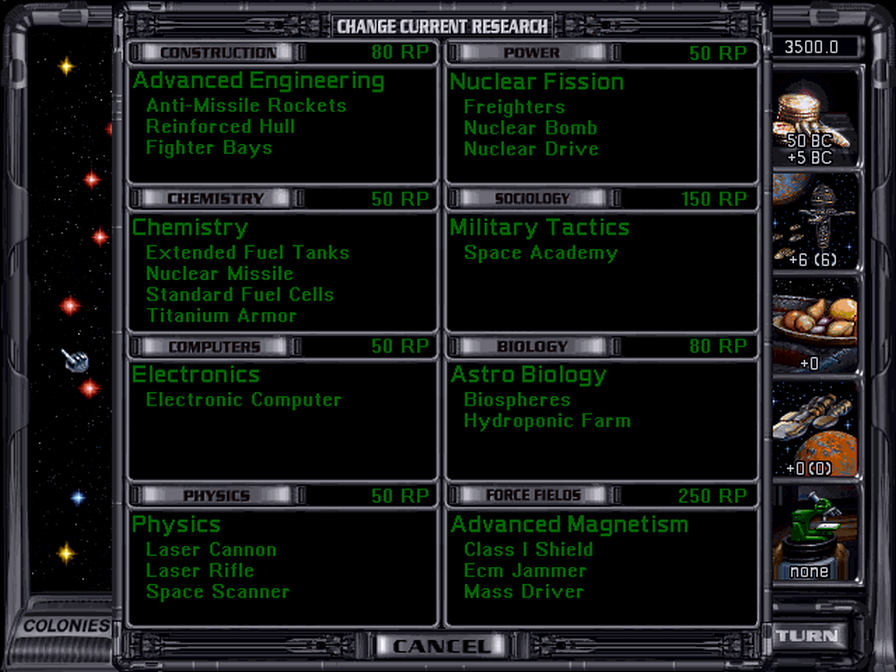
For the time being, I put half the population in farming to keep food adequate, and the other half in research. We need that most at the moment. That brings me here, via the green microscope, bottom section of the right-hand panel of the GCI. This is where the first turn will conclude with a long rant. MOO2 fans, reader discretion is advised. Hard hats and an ample supply of sedative are strong encouraged. This isn't going to be pretty.
Let's get the positives out of the way first. Some aspects of the technology system in MOO1, which I still consider to be the best ever implemented, remain. I give MOO2 credit for these even though it didn't come up with them, because there's a lot to be said about being handed a good idea and not screwing it up.
** We're keeping a lot of naming conventions; BCs, RPs, and so on. Class I Shields, Mass Driver, Anti-Missile Rockets, Extended Fuel Tanks - familar names of advances being given their new flavoring within the new system. And then there's also new options.
** The tier system remains intact. Something has to be researched from each of the now-eight instead of six fields before you can unlock anything later.
** The whole 'prototyping' period is also back. A particular research project can spend up to as long from an RP standpoint in that X% chance of discovery phase as it did to accumulate the initial minimum amount. Gone is the display bug that halved the discovery chance, but also gone is the cool lightbulb-filling graphic.
** Miniaturization and cost reduction are still a thing. In fact, they have more extensive impacts that will be explained when we get to ship design down the road.
Unforunately, many vital to mind parts of the old system were ripped out for no good reason. As a result, the MOO2 tech system is a shadow of it's predecessor. This is literally what kept me from getting into MOO2 for years. I would fire it up, forget what happened the last time, do a setup, start a game - and then literally get angry when I remembered what was going on with technology. It took me a long while to adjust my mindset around what researching in MOO means, and I had a few ragequit - don't play again for months periods.
** You never 'miss out' and have to adjust. There is one exception to this, for which I have to talk about racial traits a bit. Stock Psilons are naturally Creative, meaning they get all techs from any given tier. For the price of one of them. Yes, that's just as insane as it sounds. Stock Klackons are Uncreative, meaning they get only one from any tier - except for a few esp. at the start where everyone gets them all because they are basics. Uncreatives don't get to pick which one they get either - it's chosen for them at random. So this objection doesn't apply to Uncreatives ... but it does apply to everyone else.
If you don't have one of those two traits, which we don't and most games shouldn't esp. if you are experimenting with different setups and options, you get one but you get to pick which one it is at each tier. From all the available options. This takes an absolute hacksaw to so much strategic choice. You can't take two from a tier and accept the delay elsewhere (see: Terraforming +10 and Eco Restoration from MOO1). Can't take a missile and come back for a bomb later that's group with it. And you're never surprised. You never just don't have Radiated Landings/Planetary Shield V in your tree and have to figure out how you are going to work around that. Master-planning and defined, rigid research paths are the order of the day. You can choose one and do the exact.same.thing every time if you want. We'll see more of why that's a bad thing before long, but these kinds of considerations are a big part of what made MOO1's system so good.
The thing is, there's a pretty easy and staggeringly obvious solution here. Creatives get all techs(usually 3). Uncreatives get a random 1. Why couldn't everybody else just get a choice of two, and have to pick between those? Then you'd have a lot more unpredictability - not enough for my liking, but that would have been a major improvement just by itself.
** No cost differentials. Everything in each tier costs the same thing, which means you don't ever choose between a cheap tech to just move up the tiers and a better one that would help you more but is more costly. It's ALWAYS a choice of which tech is best within a field - you still have the option of comparing different fields of course - which means, like the previous point, there's usually one best option and there isn't often a reason to select anything else. That exacerbates any issues of under-used techs/imbalance. Similarly, there are no TL system and the side effects such as Planetology boosting your worker productivity in MOO1 either compnletely aren't a thing or are much less nuanced at a minimum.
** Only one active project at a time. The whole interest/atrophy dynamic and the tension between crash-course projects that you need NOW and the long-term strategy? Gone. Everything is a crash course. All the research goes to that one thing until it's done. Scientists have lost the ability to walk, talk, and chew gum simultaneously.
** Progress can be switched to another project at any time with no penalty. At least for those of equal or lesser cost, I don't know how it works if you switch to a cheaper one that you've already put in enough effort to complete. Allowing for switching horses in midstream without consequences means you can put off important decisions, lessening the importance of strategic planning.
** No racial distinctives. Obviously some races are better at research in general than others, but here I'm talking about within specific fields. The Klackons being strong but having that propulsion weakness that could help in slowing them down early, or the Darlok facility with computers feeding into their espionage skills, etc. from MOO1 are no longer a thing - not even in the custom traits. These played a big role in giving races a specific general profile.
All of this added together means that there are so many more mindless choices that you don't even need to consider. And when you do need to think about it, there's just a ton less to think about. The tech ladder does do some specific cool things with the new MOO2 mechanics, but that's a lipstick on a pig thing given how much the underlying system has been critically weakened. And as the manual writers specifically acknowlege, research is a really big deal in this kind of game.
Our current situation actually personifies that. The one best choice is Computers-Electronics-Electronic Computer. Not because I want the Electronic Computer specifically, although it's nice (+25 attack for ship weapons). I want what's behind it. And I know what's behind it. I know I'm going to be able to research it next, that there's exactly zero chance of me not being able to do that, so I don't need to consider odds or plan contingencies. It's a totally brainless choice once I've determined what the optimal possibility is. On the Sid Meier scale - the whole defining a game by a series of interesting decisions thing - this is only interesting up the point where you've discovered the One Right Way(tm). Then it ceases being interesting permanently.
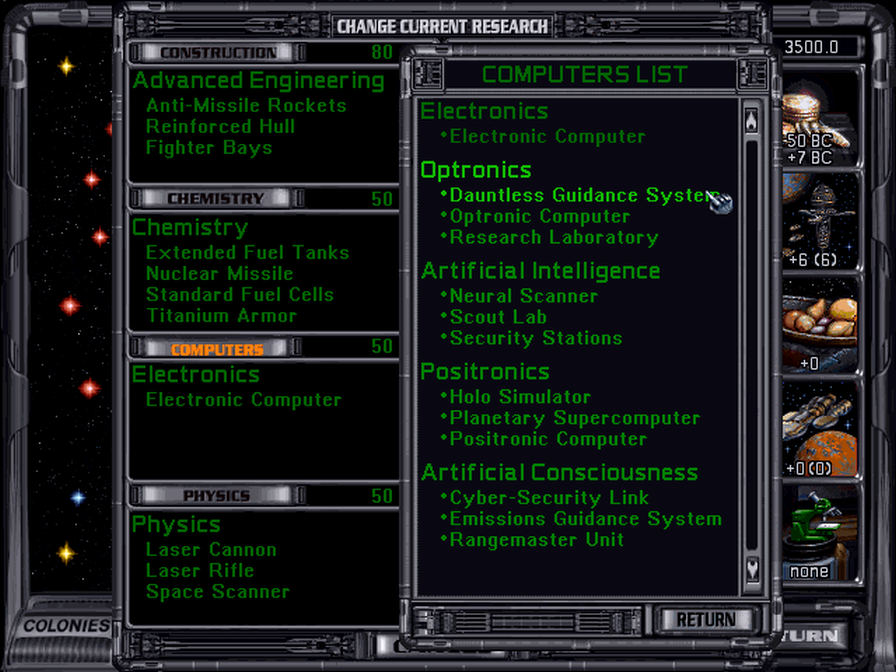
I do like this; clicking on Computers or any of the other field headings brings up a list of all possible technologies. Using right-clicking, I can check out what any of them do in-game, which is very nice.
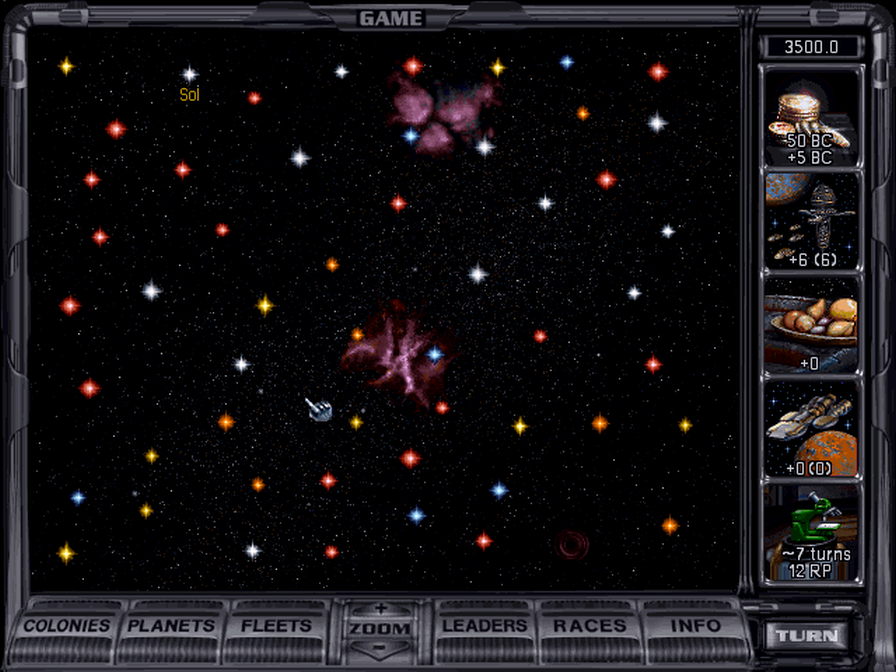
So here's the GCI with my first turn ready to finish. Profit is down to +5 BC due to the fact that I'm not building trade goods anymore. The Electronic Computer is due to finish in 7 years at 12 RP each. For now, that's all I can usefully do. We'll advance time a lot faster in some of the coming updates, and of course expand into other game systems/mechanics. We've seen here the planetary economy and the tech system, a couple of major ones that we should now have a decent handle on.